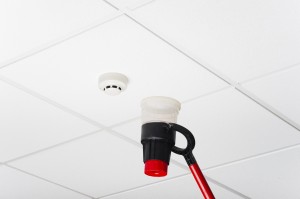Recently added item(s)
You have no items in your basket.

Commercial fire alarm systems fall broadly into two categories - conventional and addressable, and although there are still some problems with battery life and wireless coverage, increasingly sophisticated wireless systems are also becoming more common too.
BS 5839-1: 2017 is the current code of practice that makes recommendations for the design, installation, commissioning and maintenance of fire detection and fire alarm systems in non-domestic premises. Taking each of these elements in turn provides the four key pillars in supplying a commercial fire alarm system.
Design
The importance of designing the system correctly should not be underestimated. Firstly, the category of system to be installed should be determined - ideally the client or architect should specify this based on a risk assessment or the requirements of the insurance company and then a set of plans marked up. A site visit may be best if the building is already built, but in any event if the plans do not show the ceiling details further enquiry will be necessary to ensure the correct detector coverage is obtained.
An important part of BS5839-1 is the need to design the system to reduce or eliminate false alarms. It may be that a better type of detector can be specified or its position carefully selected, perhaps for example in a hotel bedroom where shower steam often can affect detectors if incorrectly sited. You can read more about how to prevent fire false alarms here in our previous blog post on the subject.
Installation
Good workmanship is essential during installation so ensure you use the recommended clips and saddles, and the correct spacing. Modern soft skin fire cables are designed and tested to be used at high temperatures, but only if they are correctly supported. The functionality of the cables in a fire situation relies on them being held in place and of course the requirement of BS 7671 Amendment 3 is to support all cables on or in escape routes with metal containment or fixings.
It is also important to record the routing of the cable on a plan. This not only complies with the need for an ‘as fitted’ drawing but is also vital should fault finding be necessary either at installation or later.
Commissioning and handover
It is vital that commissioning is undertaken carefully and correctly as systems that have not been correctly commissioned can lead to serious, potentially life-threatening consequences.
Firstly, the system needs to be inspected to ensure that it is in accord with the design. There will be a good reason why the designer required three detectors within a room, or put a break glass call point in a plant room, so you need to ensure that the design matches the installation. In fact, you also need to make sure that the building is covered to the specified category. Whilst inspecting this, the standard of workmanship needs to be carefully observed.
Check ALL equipment including cause and effect. The smoke and heat detectors are usually tested by proprietary testers, such as those in the Testifier range.
Ensure that all the sounders, beacons and relays are tested. Test and record the sound pressure readings. They must meet the requirement, which is usually 65dB, except for sleeping accommodation where 75dB at the bedhead is required.
Record everything and don’t ever assume that because a device is connected, it will set off the alarm. Test it to prove it!
Maintenance
Maintenance is critical in avoiding false alarms. Detectors do need to be checked at each service visit to ensure that there is no build-up of dirt or dust. They are best kept clean by using a detector duster spray on them.
All detectors should also be tested at least once a year. At Fire Depot we recommend and stock the Testifier range of testers to ensure that you complete the service efficiently and safely.
Life is precious and property and assets matter. For help and advice on all fire protection and safety products, please contact the Fire Depot team on 0330 999 2233, email us at sales@firedepot.co.uk or visit www.firedepot.co.uk to see our full range of fire safety products.